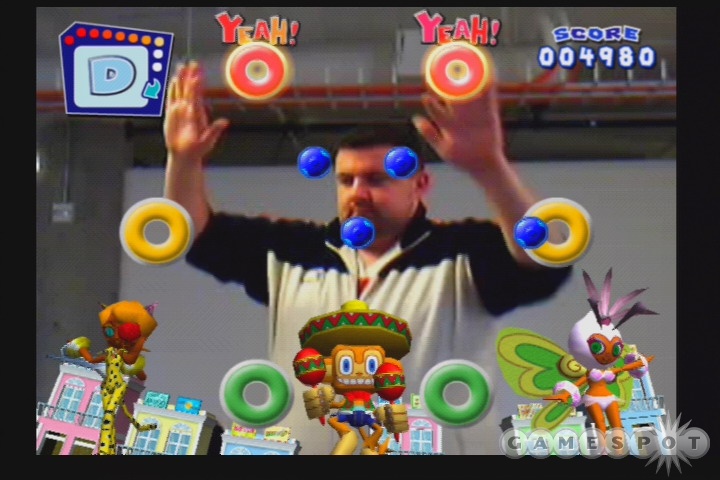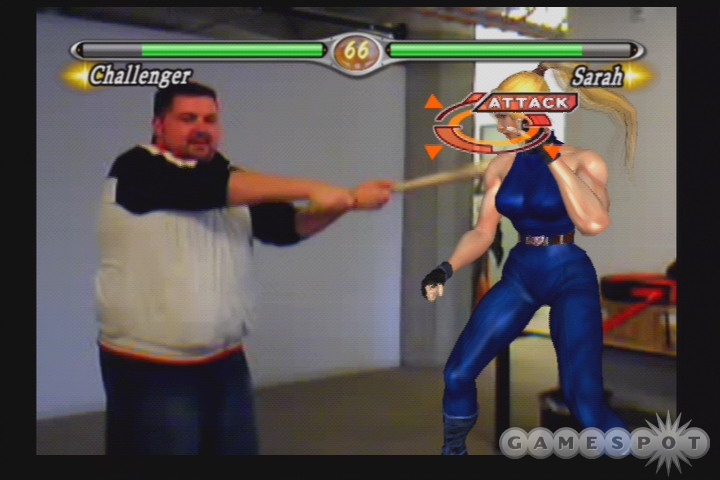Though Sony has provided a few good reasons to pick up the EyeToy, the third-party support for its novel USB camera peripheral for the PlayStation 2 has been limited to a few throwaway features in a handful of games up to now. Sonic Team breaks rank with Sega SuperStars, the short description of which is "EyeToy: Play, but with Sega characters." As with Play, the quality of the minigames can be a little uneven, but it's generally a pretty good package that should be attractive to casual and younger gamers.

What makes Sega SuperStars--and, really, all EyeToy games--so accessible is that the camera physically involves the player in the action, removing the abstraction of a 10-button gamepad. SuperStars capitalizes on this with a healthy collection of 16 different minigames that demand that the player be willing to wave his or her arms around like a maniac. There isn't really a lot of structure here. You can play any of the minigames right from the beginning, though only the easiest difficulty is available at first. SuperStars is actually a whole lot like EyeToy: Play, to the point that a few of the minigames are suspiciously familiar--replace ninjas with zombies, and Kung Foo becomes the House of the Dead minigame. But there are also plenty of really fun, original minigames in the mix. The Virtua Fighter minigame basically puts you in a one-on-one fighting game, and you'll have to whittle down your opponent's life bar by punching and kicking him or her while maintaining your own health by blocking incoming attacks. It's pretty simple, but there's a certain satisfaction to whaling on Akira and then busting out your own victory pose after he hits the dirt. The Puyo Pop Fever minigame also does a great job of involving you in the action, pouring tons of different-colored puyos on your head and shoulders and requiring you to use your body to funnel the smiling little jellies into like-colored tubes on the sides of the screen.
There are other minigames that more-closely mimic the games they're based on, and yet oddly these tend to be the least engaging. The Super Monkey Ball and Nights minigames both use a similar system, in which you move your arms up and down to control the movement of your onscreen avatar, but they require a level of precision that the EyeToy just doesn't seem capable of delivering, and though the objectives are usually pretty simple, the controls can make these games a struggle.
All the minigames included are pretty simple and easy to pick up, but sometimes this design philosophy is taken too far. Take the Crazy Taxi minigame, for example, which barely even qualifies as a game. Playing the part of someone looking for a taxi, you are required to move around enough and make enough noise to get the attention of a taxi before time runs out. It's not fun at all, and it seems specifically designed to wear out your hyperactive 8-year-old as quickly as possible. Ultimately, Sega SuperStars is at its best when it actually puts you in the action, rather than making you treat your body like a controller, contorting it in strange ways just to coax your onscreen avatar into doing what you want.
For the most part, Sega SuperStars treats playing the minigames as its own reward, though playing well can earn you some extras. There is a chao garden where you can pet, tickle, or shun one of those strange little bulbous creatures that first appeared in Sonic Adventure, and you can also use the rings you earn from completing the minigames to buy your chao food and toys. The chao garden is definitely an interesting idea, but it's hobbled by a limited amount of interactivity.

Like most EyeToy games, Sega SuperStars isn't really much to look at, since the grainy image of you coming through the EyeToy itself usually takes up most of the screen. Though you'll be looking at a mirror image of yourself most of the time, Sega SuperStars has some nice overlays that really capture the vibe of their source material. There are a few games in which your image is barely visible, and the graphics that make up the Super Monkey Ball minigame look almost as good as the real thing. The Nights minigame actually looks significantly better than the cult-classic Saturn game it's based on. Despite the radically different visual styles of all the minigames, Sega SuperStars definitely looks like a Sega game, and it sounds like one too. Almost all the music and sound effects have been lifted from older Sega games, and this works because of the nature of the package and the consistent quality of the sound. One of the few disappointments is that the Samba de Amigo minigame has only a sampling of the songs from the original game.
Sega SuperStars doesn't reinvent the EyeToy genre, and some of the games lose their appeal quickly or feel a bit too familiar, but the healthy number of minigames included in the package makes it one of best values out there for EyeToy owners. Whether Sega fans will approve will depend on how justly they feel their favorite characters have been treated here, but Sega SuperStars should be a fine purchase for EyeToy owners looking for some new fun.